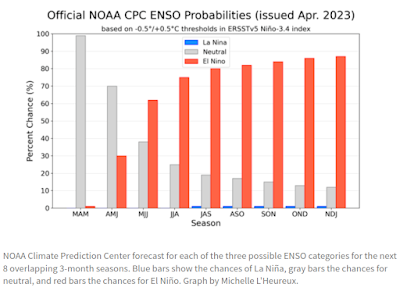
While it won't guarantee I won't be forced to evacuate my humble abode (again) this summer, it does lower the chances.
El Niño and La Niña are the warm and cool phases of a recurring climate pattern across the tropical Pacific—the El Niño-Southern Oscillation, or “ENSO” for short. The pattern shifts back and forth irregularly every two to seven years, bringing predictable shifts in ocean surface temperature and disrupting the wind and rainfall patterns across the tropics. These changes have a cascade of global side effects.
Simply put, El Niño favors stronger hurricane activity in the central and eastern Pacific basins, and suppresses it in the Atlantic basin (Figure 1). Conversely, La Niña suppresses hurricane activity in the central and eastern Pacific basins, and enhances it in the Atlantic basin (Figure 2).
The caveat being that 1992 was an El Niño year, and it saw one of the most destructive hurricanes on record (Andrew) hit South Florida, during what was otherwise a lackluster hurricane season. 1969 was an active El Niño year, which saw CAT 5 hurricane Camille slam into the upper gulf coast.
Which is why I will still be preparing this summer the same as I do every year.
Over the past three (2020, 2021, 2022) La Niña hurricane seasons, the Atlantic basin has spawned 29 hurricanes (13 of them CAT3+), causing over 250 billion dollars worth of damage, and claiming roughly 1,000 lives.
This past week, we saw the first (early) forecast for the upcoming 2023 Atlantic Hurricane season from Colorado State University, which calls for a slightly lower-than-average hurricane season ahead.
The CSU April forecast follows:
CSU released its first forecast for the 2023 Atlantic hurricane season on Thursday, April 13.
We anticipate that the 2023 Atlantic basin hurricane season will have slightly below-average activity.
Current neutral ENSO conditions look fairly likely to transition to El Niño this summer/fall. However, there is considerable uncertainty as to how strong an El Niño would be, if it does develop. Sea surface temperatures in the eastern and central Atlantic are much warmer than normal, so if a robust El Niño does not develop, the potential still exists for a busy Atlantic hurricane season. Larger-than-normal uncertainty exists with this outlook.
We anticipate a near-average probability for major hurricanes making landfall along the continental United States coastline and in the Caribbean. As is the case it only takes one hurricane making landfall to make it an active season for them. with all hurricane seasons, coastal residents are reminded that it only takes one hurricane making landfall to make it an active season for them. They should prepare the same for every season, regardless of how much activity is predicted.
Read our forecast summary here
We will get an update from CSU in early June, and the official NOAA forecast in May.
While not a certainty, NOAA gives a 62% chance that El Niño will develop by the end of July, and a greater than 80% chance of an El Niño by the fall.
The impacts of El Niño go far beyond the tropical Atlantic, and can include droughts in the Western Pacific and India, increased tropical activity in the Eastern Pacific, fewer tornadoes in the Midwest, and strong Pacific storms battering California during the winter months.
What may turn out to be good news for some, may prove detrimental for others. Which is why, regardless of where you live, it pays to get, and stay, prepared.
According to FEMA's 2021 Household Survey on Preparedness, only 59% of households took 3 or more (of 12 recommended) preparedness steps in 2021. Although that is up 2% from the 2019 survey, it is far from ideal.
So, no matter where you live . . . if a disaster struck your region today, and the power went out, stores closed their doors, and water stopped flowing from your kitchen tap for the next 7 to 14 days . . . you are you prepared with:
- A battery operated NWS Emergency Radio to find out what was going on, and to get vital instructions from emergency officials
- A decent first-aid kit, so that you can treat injuries
- Enough non-perishable food and water on hand to feed and hydrate your family (including pets) for the duration
- A way to provide light when the grid is down.
- A way to cook safely without electricity
- A way to purify or filter water
- A way to handle basic sanitation and waste disposal.
- A way to stay cool (fans) or warm when the power is out.
- A small supply of cash to use in case credit/debit machines are not working
- An emergency plan, including meeting places, emergency out-of-state contact numbers, a disaster buddy, and in case you must evacuate, a bug-out bag
- Spare supply of essential prescription medicines that you or your family may need
- A way to entertain yourself, or your kids, during a prolonged blackout


